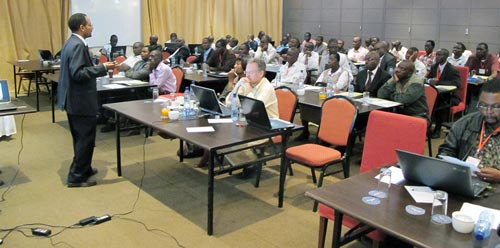 “Reducing post-harvest losses is key to increasing availability of food as it is not only important to increase domestic food production but also to protect what is produced by minimizing losses,” stated Zechariah Luhanga, Permanent Secretary, Provincial Administration at the Office of the President, Eastern Province, at the Provincial Stakeholders Workshop on Effective Grain Storage for Sustainable Livelihoods of African Farmers Project (EGSP-II) held in Chipata, Zambia, on 29 May 2013. “We as the key stakeholders and participants in the agricultural sector can enhance food security and improve incomes of resource poor farmers and artisans by promoting improved storage technologies such as metal silos and hermetic bags in Zambia.”
“Reducing post-harvest losses is key to increasing availability of food as it is not only important to increase domestic food production but also to protect what is produced by minimizing losses,” stated Zechariah Luhanga, Permanent Secretary, Provincial Administration at the Office of the President, Eastern Province, at the Provincial Stakeholders Workshop on Effective Grain Storage for Sustainable Livelihoods of African Farmers Project (EGSP-II) held in Chipata, Zambia, on 29 May 2013. “We as the key stakeholders and participants in the agricultural sector can enhance food security and improve incomes of resource poor farmers and artisans by promoting improved storage technologies such as metal silos and hermetic bags in Zambia.”
The workshop had five main objectives: (1) to provide a forum for exchange of ideas, information, and research outputs on EGSP-II among stakeholders in Chipata; (2) to raise awareness on post-harvest losses and dissemination of effective grain storage technologies among provincial stakeholders; (3) to consult provincial stakeholders on effective postharvest technologies, policy environment, and market issues for the purpose of refining, updating, and implementing EGSP-II; (4) to engage in policy dialogue on matters related to storage and find means of enhancing adoption of the technology; and (5) to acquaint key stakeholders in the province with the post-harvest technology and ways to enhance its adoption among farmers.
Maize suffers heavy post-harvest losses estimated at 20-30%. “The main underlying factor is that most of the small-scale farmers do not have access to improved storage facilities,” explains Tadele Tefera, CIMMYT entomologist and EGSP-II coordinator. Ivor Mukuka, EGSP national coordinator for Zambia, noted that since the larger grain borer was first found in Zambia in 1993, there have been sporadic outbreaks causing substantial losses in maize. “For instance, rapid loss assessments in Lundazi and Chama districts revealed losses ranging from 5-74%. Other studies indicate storage losses of between 45-90% based on farmers’ estimation,” he added.
Luhanga reminded participants that grain post-harvest management development requires active participation of all stakeholders, including government, research systems, non-governmental organizations, and the private sector in bringing the technologies to farmers’ doorsteps. “You need to make sure to set priority activities so that they address the challenges faced by smallholder farmers regarding maize grain post-harvest management, but also expand their opportunities in the maize sector,” Luhanga urged more than 50 stakeholders present in the meeting.
Besides post-harvest loss reduction, the metal silo technology provides huge business opportunities to artisans. “Engaging in metal silo fabrication and marketing can create jobs and rural enterprise development,” said Egbet Munganama, principal agricultural engineer at the Department of Mechanization, Ministry of Agriculture and Livestock, Zambia. According to Jones Govereh, EGSP policy analyst, artisans can earn over US$ 3,000 per year if they fabricates just five silos a month on average. “This is an attractive income for micro-entrepreneurs but commercially oriented entrepreneurs can earn much more,” he explained.
“Improved maize storage technologies have a great potential impact on food security as most households lose much of their maize due to poor storage facilities,” concluded CIMMYT principal economist Hugo De Groote, considering that maize is the major food crop in Zambia.
Tadele thanked the Swiss Agency for Development and Cooperation (SDC) for funding EGSP-II, a project aiming to reduce post-harvest losses, enhance food security, and improve incomes of resource-poor farmers in Zambia.
 Innovations
Innovations